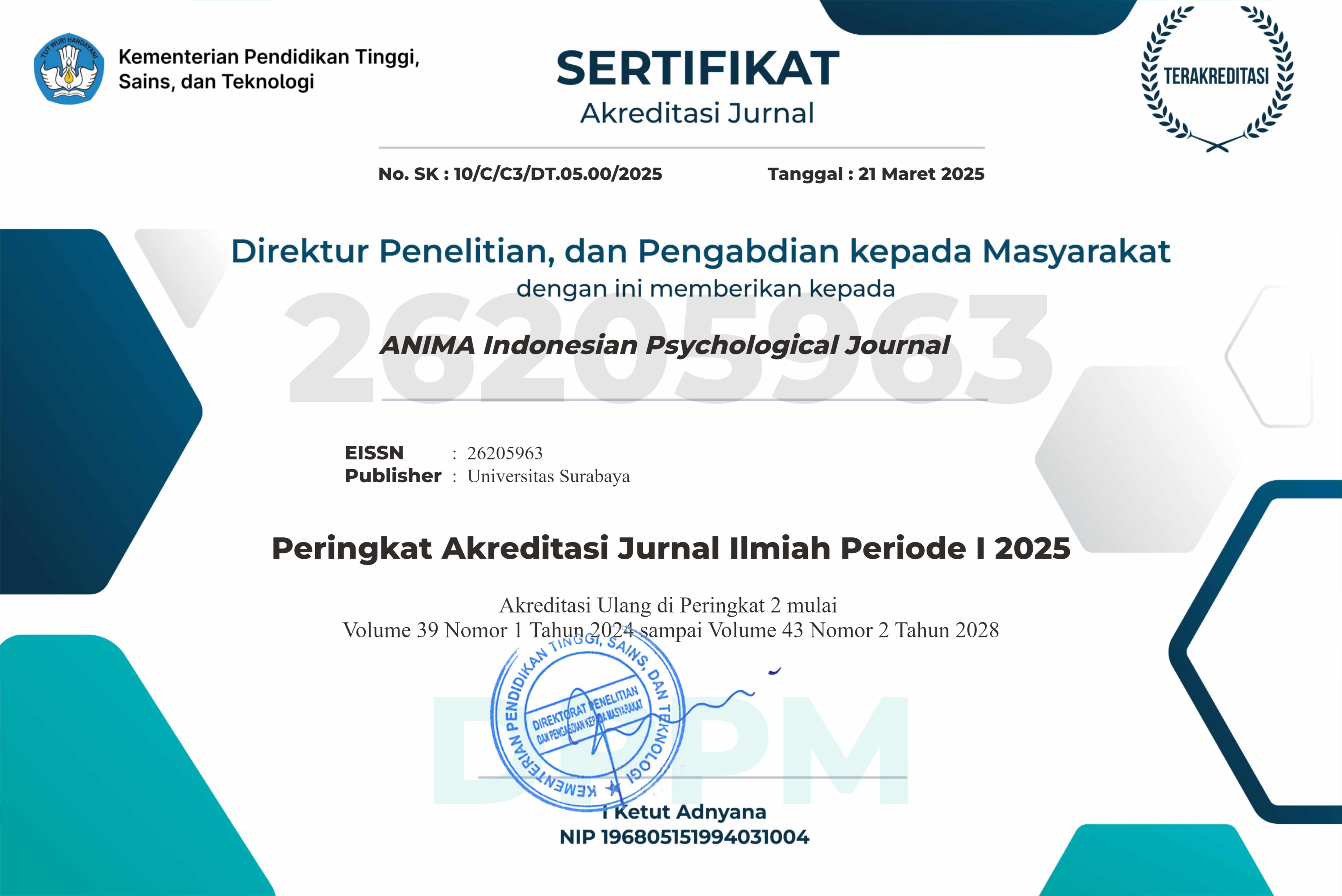Individual Well-Being of the Elderly in Surabaya–Indonesia and Hangzhou–China
 Abstract Views:
235 times
Abstract Views:
235 times
 PDF-Full Text Downloads:
137 times
PDF-Full Text Downloads:
137 times
Abstract
Various researches indicate that the increase of age is not in parallel with the increase of well- being, similarly cultural pattern influences individual life quality. The problem revealed in this study was whether there is a (significant) difference between the well-being of elderly individuals in Surabaya-Indonesia and Hangzhou-China. The sample of this research (N = 193: Indonesia = 102, China = 92) is 60-year-old or over seniors, both men and women living in Surabaya and Hangzhou, collected by the incidental sampling technique. The collection of data was using Psychological Well-Being Scale (Diener et al., 2009). The result of this study shows that there is a significant difference of well-being between respondents in Surabaya and Hangzhou In general, there is a bigger opportunity to achieve the self-potentials of respondents in Hangzhou, making their well-being level higher than the respondents in Surabaya. Furthermore, the differences of the results are further discussed.
Berbagai penelitian menunjukkan bahwa peningkatan usia tidak sejalan dengan peningkatan wellbeing, demikian pula pola-pola budaya memengaruhi kualitas hidup individu. Permasalahan yang diungkap dalam penelitian ini adalah apakah ada perbedaan wellbeing antara individu lanjut usia (lansia) di Surabaya-Indonesia dan di Hangzhou-Cina? Sampel penelitian ini (N = 193: Indonesia = 102, China = 92) lansia berusia 60 tahun atau lebih yang tinggal di Surabaya- Indonesia dan di Hangzhou-Cina, yang diambil dengan teknik incidental sampling. Pengumpulan data menggunakan Psychological Well-Being Scale (Diener et al.,2009). Hasil penelitian menunjukkan ada perbedaan well-being antara lansia di Surabaya-Indonesia dan di Hangzhou-Cina. Secara umum, dengan budaya yang berbeda lansia di Hangzhou mempunyai pengalaman dan cara yang berbeda dalam memenuhi kebutuhan, merealisasikan potensi maupun memberikan penilaian terhadap kualitas hidupnya. Selanjutnya dibahas perbedaan- perbedaan dalam hasil tersebut.
Downloads
References
Diener, E., Wirtz, D., Biswas-Diener R., Tov, W., Kim- Prieto, C., Choi, D. & Oishi, S. (2009). New measures of well being. In E. Diener (Ed.). Assessing well being: The collected works of Ed Diener. Champaign, IL: Springer Science+Business Media B.V.
Diener, E. (1984). Subjective well-being. Psychological Bulletin, 95, 542-575.
Maslow, A. H. (1958a). A dynamic theory of human motivation. In C. L. Stacey, & M. F. DeMartino, (Eds.), Understanding human motivation (pp. 26- 47). Cleveland, OH: Allen. doi:10.1037/11305-004
Maslow, A. H. (1958b). Emotional blocks to creativity. Journal of Individual Psychology, 14, 51-56.
Maslow, A. H. (1958c). Higher and lower needs. In C. L. Stacey, & M. F. DeMartino, (Eds.), Understanding human motivation (pp. 48-51). Cleveland, OH: Allen. doi:10.1037/11305-005
Lee, M., Baretto, M., & Frazier, L. (2004). Personality and well-being: Adult age differences. The Gerontologist, 44,1.
Peterson, Christopher; Seligman, Martin E. P. (2004). Character strengths and virtues: A handbook and classification. Oxford: Oxford University Press.
Pirkl, J. (2009). Characteristics of our aging population. The Demographics of Aging. Retrieved from http://www.transgenerational.org/aging/demographics.htm
Ryan, R.M., & Deci, E.L. (2001). On happiness and human potential: A review of research on hedonic and eudemonic wellbeing. Retrieved from http://www. uic. edu/classes/psych/health/readings/Ryan,%20Happiness%20-%20well%20being,%20AnnRevPsy,%202001.pdf
Ryff, C.D. (1989). Happiness is everything, or is it? Explorations on the meaning of psychological well-being. Journal of Personality and Social Psychology, 57(6), 1069-1081
Ryff, C.D., & Keyes, C.L.M. (1995). The structure of psychological wellbeing, Retrieved from http:// www.midus.wisc.edu.findings/pdfs/830.pdf
Ryan, R. M., & Deci, E. L. (2000). Self-determination theory and the facilitation of intrinsic motivation, social development, and well-being. American Psychologist, 55, 68–78.
Seghieri, C., Desantis, G., & Tanturri, M. L. (2006). The richer, the happier? An empirical investigation in selected European Countries. Social Indicators Research, 79(3), 455-476.
Suh, E., Diener, E., Oishi, S., & Triandis, H. C. (1998). The shifting basis of life satisfaction judgments across cultures: Emotions versus norms. Journal of Personality and Social Psychology, 74, 482-493.
Tira (2012). Populasi lanjut usia tahun 2050 mencapai 2 milyar. Retrieved from http://rehsos.kemsos.go.id/modules.php?name=News&file=article&sid=1602
Wood, W., Rhodes, N., & Whelan, M. (1989). Sex differences in positive wellbeing: A consideration of emotional style and marital status. Psychological Bulletin, 106(2), 249-264.

This work is licensed under a Creative Commons Attribution-NonCommercial-ShareAlike 4.0 International License.
Articles published in ANIMA are licensed under a Creative Commons Attribution-NonCommercial-ShareAlike 4.0 International license. You are free to copy, transform, or redistribute articles for any lawful, non-commercial purpose in any medium, provided you give appropriate credit to ANIMA and the original Author(s), link to the license, indicate if changes were made, and redistribute any derivative work under the same license.
Copyright on articles is retained by the respective Author(s), without restrictions. A non-exclusive license is granted to ANIMA to publish the article and identify itself as its original publisher, along with the commercial right to include the article in a hardcopy issue for sale to libraries and individuals.
By publishing in ANIMA, Author(s) grant any third party the right to use their article to the extent provided by the Creative Commons Attribution-NonCommercial-ShareAlike 4.0 International license.




